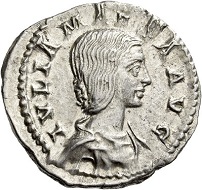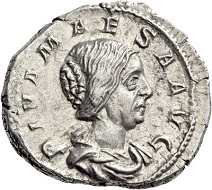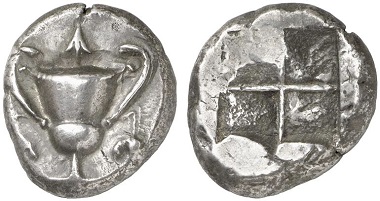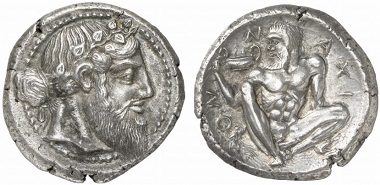by Alan Walker
April 12, 2018 – Do you have to do with ancient coins? Did you ever ask yourself where they are coming from? Alan Walker of Zurich Nomos AG will presents a comprehensive overview of this crucial subject. The third part deals about lost coins and features a final remark.
If you want to start reading from the very beginning, you will find the first part about hoards here.
3) Losses
The basic difference between losses and hoards or deposits is that unlike the latter, which were deliberately placed where they were ultimately found, losses are just that: inadvertently dropped and not recovered. While there is a tendency among some archaeologists to label any group of two or more coins a hoard or deposit, this is clearly mistaken: as I must emphasize, hoards or deposits were intentionally placed, while losses were lost by chance, or at least, deliberately discarded.
Nomos 14, 2017, 398. Julia Maesa, from the Nis Hoard of the early 1930s. Est. 200 / Hammer 160 CHF.
a) Ordinary Losses
Imagine that you are a visitor to ancient Greek trade fair, held annually outside an important Peloponnesian town on a convenient group of fields. As you walk around you see all sorts of goods, brought from all over the classical world: from nearby Athens as well as from Sicily and Carthage; from the Greek cities of Asia Minor, as well as from Egypt and Phoenicia; there are high quality local agricultural products like olive oil, as well as oil from Magna Graecia and, even, Spain. While you are wandering around, marveling at what you see, you remind yourself that you have a purse or a pouch in which you have bronze and silver coins to buy things that catch your fancy. Just when you are about to buy something you get jostled and your coins fall over a stand table! Damn! You find most of them but some just seem to have disappeared into the ground. Or, even worse, you realize that your money pouch is gone! Either some ancient equivalent of the modern pickpocket got it from where it was attached to your belt (remember, pockets actually did not come into use until around the 13th century), or it simply fell off from where you had it. These are just some of the explanations we have for losses: the careful modern recording of the find spots of metal detector finds, as well as those from careful excavations, has given us evidence for the presence of ephemeral market tables, or even for the places where certain types of people would gather. This is one of the good reasons why so many archaeologists hate illegal metal detectorists: they do not record precise find spots (or even any find spots!). Modern field surveys have been able to localize market areas by the way coins are found on what seem to be a grid system, shadowing ancient paths. In the Agora of Athens the presence of what must have been temporary stalls selling tourist souvenirs along the Panathenaic Way to the Acropolis is almost certain due to the scatter of minor bronze coins that were excavated along that road and in the drains that flanked it. By the way, if you go to a modern religious pilgrimage site, like Einsiedeln in Switzerland, you will find loads of shops selling religious paraphernalia in the plazas before the sanctuaries: many may decry the things sold as kitschy gimcrack, but visitors love them, and in ancient times exactly the same kind of material was sold to the ancient pilgrim.
Nomos 14, 2017, 407. Diva Julia Maesa, from the Nis Hoard of the early 1930s. Est. 800 / Hammer 1,700 CHF.
One of the most spectacular ways that the carefully recorded find spots can provide us with totally unexpected information comes from the site of Nemea in the Argolid. The sanctuary of Nemea ran Panhellenic games that were held every second or third year; when the stadium was excavated in modern times quite a few coins were found on the earthen banks on which the spectators stood (unlike other ancient stadia, there were no permanent seats). Of interest is the fact that while the stadium was normally cleaned and refurbished after the games were held in preparation for the forthcoming one, the state of the stadium as excavated showed that it had gone out of use after the games held in the late 4th century. As such, all the debris from the last games (broken crockery and lost items – as coins) was still on the ancient ground surface. When the find spots of all the coins were plotted it turned out that coins from certain groups (i.e., Argives, Sicyonians, et al.) were found in specific areas, thus showing that spectators from the different cities that took part in the games formed cheering sections, just like they do at modern sports events.
Small groups of coins that seem to be related but which show no signs of having been in a durable container, or having been deliberately hidden, can best be described as lost purses. High value coins, such as ancient or later gold coins, do turn up singly (studies have been done on single finds of aurei in France, for example): while if single finds of gold pieces have been consistently found in a specific field they could be explained as being from a hoard scattered by plowing, and others, if found in the right places, may be votives, many can only be losses, just like bronzes or silver pieces. The occasionally enormous numbers of surface finds that are swept up from the sites of many ancient cities are almost entirely derived from ordinary losses. What such losses provide us are snapshots of the coinage in circulation at the time the coins were lost.
One of the most interesting of all lost purses was found in the burnt ruins of the Odeon of Agrippa in the Athenian Agora. The Odeon was destroyed during the Herulian sack in 267, but the purse primarily consisted of Roman Imperial bronze coins dating up to c. 144. However, since the roof of the Odeon collapsed in c. 150, but was immediately repaired and remodeled, what we must have is the purse of one of the men fixing the roof in c. 150, which by chance was lost and slipped into the roofing. So when the building was burnt down in 267 it fell to floor. This has always been a particularly intriguing example of how the date of a “hoard” can be completely different from the date of the destruction in which the coin is found.
Nomos 1, 2009, 88. Naxos, Kyklades, from the Santorini Hoard of 1821 (IGCH 7). Est. 40,000 / Hammer 38,000 CHF.
b) Deliberately Discarded Losses
These are coins that are deliberately thrown away, rather than being accidentally lost. The main type of these are forgeries. Ancient coin forgeries go back to the beginning of coinage. Base metal cores were plated with gold, electrum or silver in order to deceive users. Agora 659 is an especially clever fake, which was given two test cuts prior to being plated! However, since knowingly passing a fake was a criminal offense in ancient times, once it became obvious that a coin in question was false, its then owner would simply throw it away! As a result, a surprising number of ancient fakes turn up in archaeological excavations as single finds (like those ‘Limesfälschungen’ from the Roman frontiers in Germany).
Final Remarks
Thus, hoards, deposits and losses are the sources for all the coins that are today in our collections whether private or in museums; on the market; or found in the ground, either as chance finds or in excavations, whether done by archaeologists in a professional way (one hopes) or by illegal diggers (ipso facto in an unprofessional way).
Obviously, any coin that is dug up without any form of record loses all archaeological relevance: it is still an ancient coin, it still has some iconographic or art historical importance, it is still an historical document, but we do not know exactly where it was found – and even if we do we don’t know what its context was. This is especially true for chance finds and for coins found by looters in archaeological sites: the coins that could have provided information about when they were used (and where), and that could have dated the construction of the buildings in which they are found, lose all the evidentiary value.
However, it should be pointed out that single finds, whether on the surface or dug up using metal detectors, while perhaps of great archaeological importance, are often of truly negligible commercial or collecting importance. This apparently paradoxical situation is caused by the fact that the vast majority of archaeologically found single coins are damaged by corrosion to such an extent that they are effectively only of very minor commercial interest.
Of course, if the soil is particularly forgiving, excavated coins can be remarkably free of corrosion: when I was digging in Dorchester long ago, where the sub-soil was of chalk, bronze coins (and objects) came out in a marvelous state with a lovely patina, and only needed to be brushed prior to being recorded. When I was working in Athens the late M. Oikonomedes, curator of the Numismatic Museum, showed me several trays of bronze coins from the then new excavations at Nikopolis in Epirus: while some had encrustations, not only were all legible but all had wonderful surfaces.
On the contrary, in the Athenian Agora, from 1931 to 1990 approximately 16,500 coins were found and retained as being ‘Greek’, primarily Athenian but from a considerable variety of other mints (a further 4,000 or so were so horribly corroded and/or worn that they could only be identified as being probably Hellenistic Greek and were discarded, probably in the very late 1940s or early 1950s prior to the reconstruction of the Stoa of Attalos). The soil of the ancient city of Athens is so hostile to metals that the vast majority of coin finds had to undergo drastic cleaning measures to enable them to be identified. Anyone viewing the plates of Agora XXVI, the publication of the Greek coins from the Agora, can easily see the rough and messy surfaces that so many of the coins have (and the coins illustrated are the best preserved). In short, well over 95-98% of the Agora Greek coins would be of little interest to collectors or commerce (and the illustrations are all taken from plaster casts for clarity – the actual coins are by no means as clear).
Nomos 1, 2009, 25. Naxos, Sicily, from the Randazzo Hoard of 1980. Est. 400,000 / Hammer 775,000.
Yes, large amounts of surface metal detector finds do enter the world market, and the scientific loss can be serious, but the real problem is that so much of this material is what commerce terms ‘junk’. If all this material could be identified and have its find spot recorded we would learn an immense amount. But, of course, except in England, where finders who declare their finds are rewarded by the PAS when what they find is deemed of national or local importance, or have their finds returned to them if no national or local museum wants them, confiscatory laws and derisory rewards mean the finders almost invariably seek to sell their finds on the black market (and, alas, thanks to insufficient penalties illegal finders flout the law in England too).
In my personal experience, before Switzerland enacted very serious import regulations, all sorts of people used to arrive with sacks of surface finds that they were convinced were worth a fortune. It was then my duty, since Silvia Hurter and Leo Mildenberg did not want to be bothered, to tell the people that their treasures were basically worthless, and we certainly had no interest in buying them. They would invariably get furious, especially when I would tell them that it would have been better and more profitable to have kept the coins in their own country rather than smuggling them out and, then, smuggling them in to Switzerland. The legal sanctions were far and away more drastic than that of the coins’ value. They would look at me like I was crazy. Even worse, most of the time these people cleaned the coins themselves, effectively completely destroying what little value they originally had: they would dump piles of bronze coins into petrol/gasoline and they’d come out looking like shiny pennies!! Fair laws, with decent rewards for material of real interest and with everything else returned to the finder and/or land owner, would have kept all this material in the home country, with records of where it was found, rather than ultimately being tossed into boxes of “junk” in Munich or London!
Another point is that once those coins are dug up unrecorded from sites all over the greater Mediterranean world, their contexts and archaeological importances are irretrievably lost (remember, many, many coins have an archaeological value far, far above their commercial worth).
But hoards, from which the vast majority of truly collectible coins come, are often of far less archaeological value. Not always. Emergency hoards from urban sites really do help to date the site’s destruction, but so many hoards are actually primarily of numismatic rather than archaeological importance. The great Meydancikkale Hoard from near modern Gulnar in Cilicia was found in three large pottery vessels buried under the floors of an ancient building – there seem to have been no signs of destruction so this was apparently a form of savings hoard. Archaeologically it tells us little, but numismatically it was of real importance for refining the chronology of the issues of Pergamum, the Ptolemies and of the Posthumous Lysimachii. Many other hoards have been found outside of archaeological zones, often far from habitations: once again, their contents were, unlike all those single finds, or emergency hoards found in destruction levels, primarily of importance for numismatic questions, not archaeological ones. The great Dekadrachm/Elmali Hoard seems not to have had any serious archaeological context, and numerous major Ancient British and Roman hoards from England are often from areas of no apparent archaeological interest.
To end, and to show quite how wacky the present situation is becoming, here is a quote from the latest US MOU with Libya, listing a type of thing classed as an archaeological object that needs to be restricted from entering the USA:
“3. Rope–Rope and string were used for a great variety of purposes, including binding lifting water for irrigation, fishing nets, measuring, and stringing beads for jewelry and garments.”
Isn’t this wonderful? Soon containers of rope and string will start being sent back to Libya, saving them from the hands of all those avid collectors of Libyan rope and string, dating from the Neolithic Period through 1750!
I am not making this up.
We are sure that everybody knows who Alan Walker is, nevertheless, for those who don’t or who have forgotten, here’s the link to our numismatic Who’s who.
Don’t miss Part II: Deposits of Alan Walker’s three-part series on hoards.
You can find the contact details of Alan Walker on the Nomos website.
More articles on treasure finds are available in our respective archive section.







